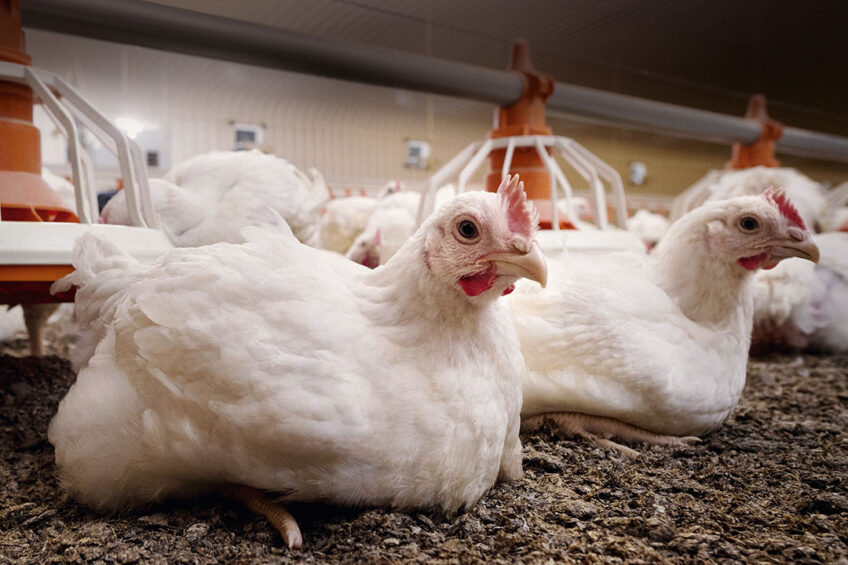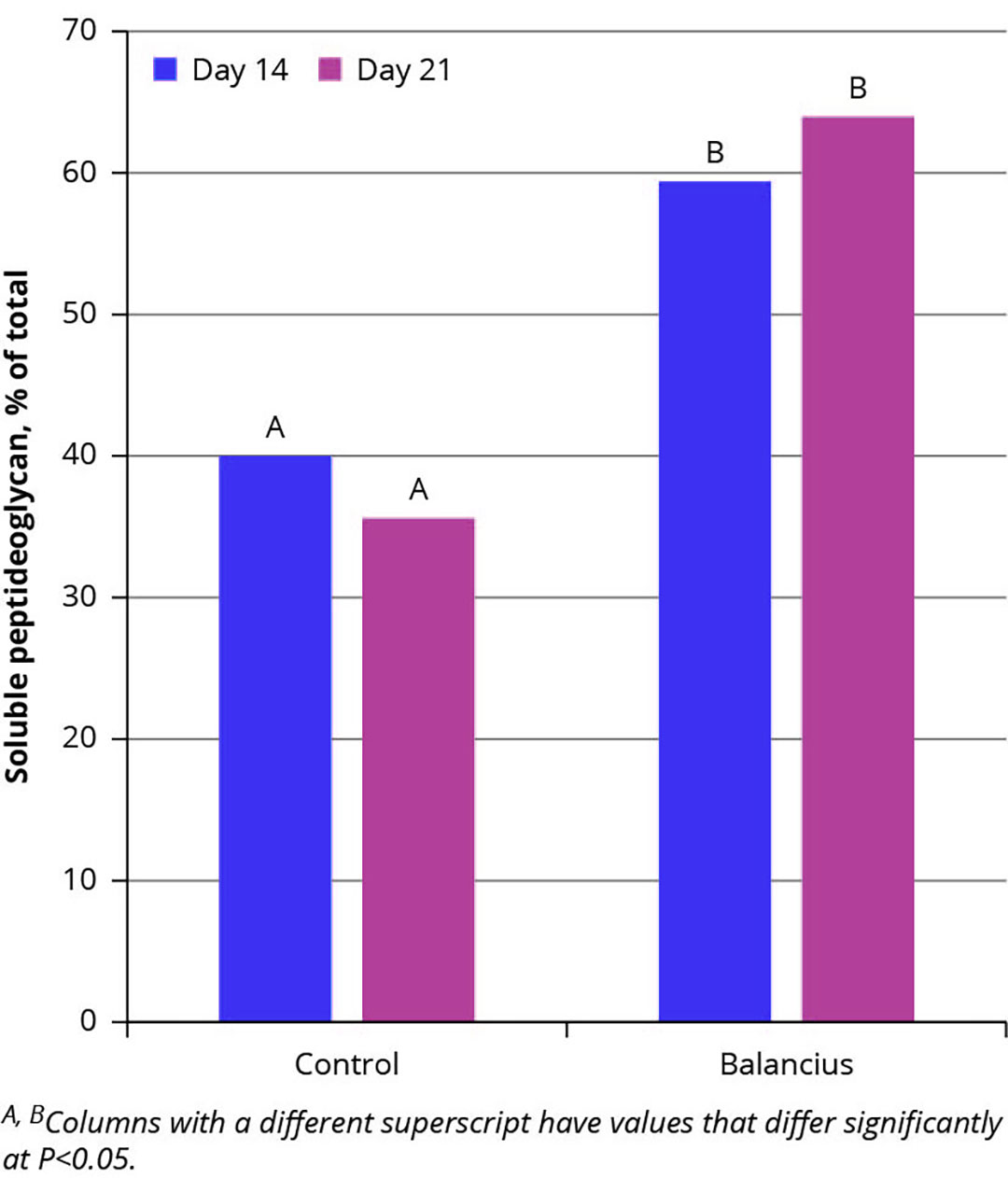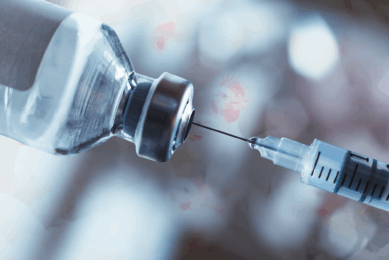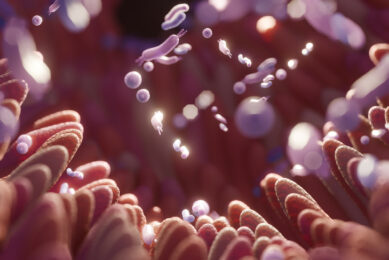Gastrointestinal functionality: Peptidoglycans and immunity

The reduction and removal of antibiotics from poultry diets requires a 360o approach including good farm management, nutrition, biosecurity, hygiene and a robust health and vaccination programme.
From a nutritional aspect, considerable solutions have been developed as gut health solution promoters such as optimisation on dietary composition and different type of feed additives including pre & probiotics, symbiotics, phytogenics and enzymes that all support gastrointestinal functionality. Various research studies show that a strong relationship and impact between poultry feed from one side and intestine barrier, microbiota, digestion and absorption as well as with immunity on another, increase the importance of gastrointestinal functionality for achieving optimum performance in poultry.
One of the most important factors in the health of the gastrointestinal functionality is bacterial debris and peptidoglycans as a main part in this structure may have a strong effect on gut and poultry performance. Commensal bacteria in the gut may not cause inflammation but fragments from any bacterial cell wall can significantly reduce the gut functionality. During bacterial turnover, a significant quantity of peptidoglycans (PGNs) is released in the lumen, and intestinal Lysozyme can degrade part of PGNs to decrease signals of potential inflammation in the intestine. Muramyl dipeptide (MDP) as result of PGNs degradation show anti-inflammatory effects on specific intracellular receptors (NOD2) in basolateral surface of epithelial cells.
Because of the genetic potential for growth, modern broilers have high feed intakes and fast feed passage rate into the gastrointestinal tract, but insufficient production of many of endogenous enzymes, not only decrease the digestibility of feed ingredients but also effect many aspects of gut functionality negatively. PGNs degradation is not exceptional from this development and endogenous lysozyme cannot breakdown all PGNs present in the intestine, so an exogenous muramidase such as Balancius can increase the capacity of PGNs degradation from dead bacterial cell walls and support gastrointestinal functionality.
PGNs and gut inflammation
Goblets cells play an important role in the intestine and overall immunity via mucus secretion, containing antimicrobial proteins. Studies show supplementation of muramidase in broiler diets increases the density of goblet cells significantly in the duodenum and jejunum. This increase might also be due to NOD activation by muramyl dipeptide (MDP) formed through muramidase degradation of peptidoglycans.
Further research studies show the usage of exogenous muramidase in broiler feed increases intraepithelial lymphocyte (IEL) in the duodenal and jejunal mucosa. Intraepithelial lymphocytes function as sentinels in the maintenance of mucosal barrier integrity and play an important role in tolerance induction by producing anti-inflammatory cytokines. Therefore, the expansion of the intraepithelial lymphocyte population in the intestine epithelium of broilers might be triggered by MDP activation of NOD receptors.
In addition, the application of exogenous muramidase such as Balancius in broiler diets decreases T-cell densities in the duodenum and ileum, serving as a rough indicator of inflammatory responses in the gut. The mode of action of muramidases show the activation of NOD2 via producing MDP from PGNs degradation plays an important role in the gut performance of broilers. This positive effect on the gut may have a direct impact on performance parameters and immunity of broilers.
Significant improvement in performance
Research studies show significant improvement of broiler performance (FCR and BWG) with adding exogenous muramidase in broiler diets, also European Production Efficiency Factor (EPEF) was significantly higher in broilers fed exogenous muramidase in the diet than control group (431 vs 403). Dietary energy improvement and an increase on ileal digestibility of essential nutrients are established in different studies and suggested an improvement in absorption capacity and gut functionality.
Our research studies (unpublished) found significant improvements when using Balancius in broiler diets on histological parameters of the small intestine. These data show a significant improvement (P<0.05) on mucosal thickness, villus height and width, villus surface area and crypta ratio (Table 1). It is assumed that an increase of villus height is paralleled by an improvement in digestive and absorption function of the intestine due to an increase of the absorptive surface area, expression of brush border enzymes and nutrient transport system.
Crypts contain stem cells as a proliferation centre of the intestinal epithelium. They can migrate up and create enterocytes which are a major cell type in the intestinal epithelium and play an important role in the nutrient absorption and secreting immunoglobulins.
Moreover, under commercial condition, the product is used by some of the biggest and most progressive poultry companies. Based on results of complex-wide trials, the product has been shown to:
- improve nutrient digestibility and absorption and overall gut functionality
- contribute to more sustainable poultry production by improving FCR
- better animal welfare by keeping litter drier
- better quality by improving breast meat yield and uniformity.
A recent study demonstrated the breakdown of PGNs with the inclusion of Balancius in broiler diets (Figure 1). In this study using different levels of PGNs (some diets included feature twice the amount of PGNs that broilers would be exposed to under standard conditions) significantly increased the solubility of peptidoglycans in the small intestinal digesta.
Figure 1 – The addition of an exogenous muramidase (Balancius) increased the % of soluble PGNs, in jejunal digesta of broilers on day 14 and 21 (Jansman et al. – unpublished).

Conclusion
In gram positive bacteria, PGN accounts for more than 20% of bacterial cell walls. The positive effect of exogenous muramidase on nutrient absorption may come from reducing PGNs as a residue of dead bacterial cell walls by increasing absorption surface for nutrients and decreasing gut inflammation. The results of the availability of essential nutrients not only improves performance parameters but may also improvement the immune system in the gut.






